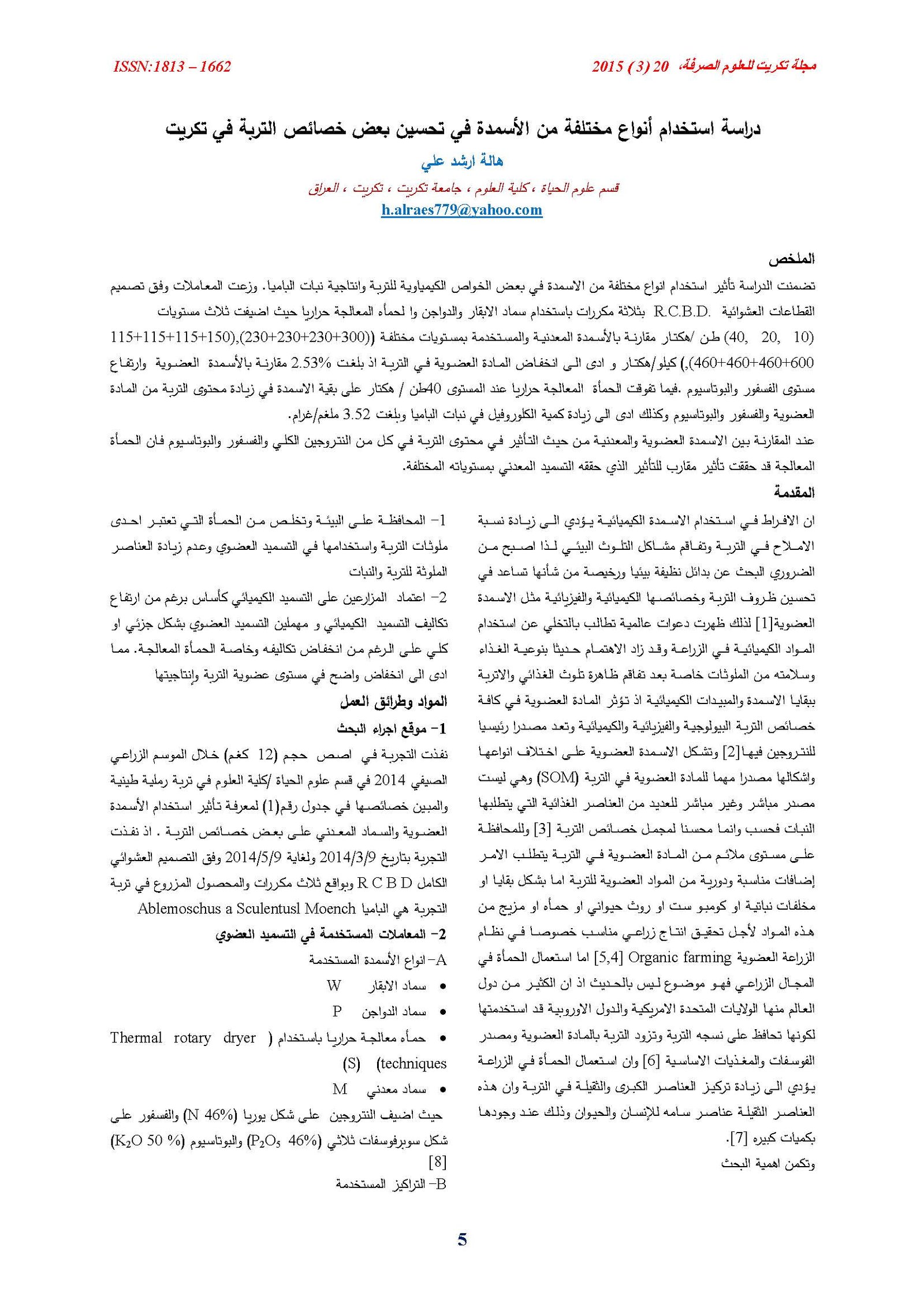The usage of different fertilizer type in same soil character ization improvements in Tikrit
Main Article Content
Abstract
This study included the effected of using different types of organic fertilizer in some soil chemical characterization productivity of okra plant. The experiment were designed according (R.C.B.D), with three replicates by using fertilizers remnants of cows and poultry, sludge were used. Three levels(10,20,40) ton/hectare were used in comparison with different levels of mineral fertilizer (150+115+115), (230+230+300), (460+460+600) Kg/hectare .This treatment resulted in reduction of soil organic materials, which approached 2.53% as compared with organic fertilizers and increased, phosphorus and potassium levels. While the sludge treatment increased organic material ,phosphorus and potassium over 40 ton/hectare, as well as in an increase in the plant chlorophil contents. This increase was approximately 3.52mg/g. In overall comparison between the various fertilizers, the sludge produced equal effect with the different mineral fertilizers levels.
Article Details

This work is licensed under a Creative Commons Attribution 4.0 International License.
Tikrit Journal of Pure Science is licensed under the Creative Commons Attribution 4.0 International License, which allows users to copy, create extracts, abstracts, and new works from the article, alter and revise the article, and make commercial use of the article (including reuse and/or resale of the article by commercial entities), provided the user gives appropriate credit (with a link to the formal publication through the relevant DOI), provides a link to the license, indicates if changes were made, and the licensor is not represented as endorsing the use made of the work. The authors hold the copyright for their published work on the Tikrit J. Pure Sci. website, while Tikrit J. Pure Sci. is responsible for appreciate citation of their work, which is released under CC-BY-4.0, enabling the unrestricted use, distribution, and reproduction of an article in any medium, provided that the original work is properly cited.
References
2- Schionning , P.; Elmhot , S. and Christensen , B.T (2004). Managina soil Quality – challenges in modern Agriculture. CABI publishing: 344 pages.
4-Schorth, G. and Sinclair, F. L. (2004). Trees, crops and soil Fertility. CABI publishing. 437 pages.
5-Rivero, Carmen, Chirenje, T., Ma, L. Q. and Martinez, G. (2004). In fluence of compost on soil organic matter quality under tropical condition. G eoderma . 132:355-361.
6-Sims, J.T. and sharpley, A. N. (2005). Phosphorus agriculture and the environment . ASA, CSSA, and SSSA. Madison WIP: 1021- 1068.
7- Korboulewsky Nathalie, Sylvie Dupo yet and Gilles Bonin 2002. Environmental Risks of Applying Sewage Sludge Compost to Vineyards. Journal of Environmental Quality 31:1522-1527.
9- Anna, D, M. Allen and F. Whatly (1954). Naturne, (lond).,174-394.
10- Walkley. A (1947). Acritical examination of arapid method for determining organic carbonin soil: effect of variation indigestion condition and organic soil constituents soil. Sci 63:251-263.
11-Brermner, J. M. and mulvancy, C. S(1987). Nitrogen total .P. 595-624. Inal page (ed). Methods of soil analysis-Agron No.9. part 2:chemical and Microbiologyical properties. 2nd ed. Am. Soc. Agron medison. WI. USA.
12-chapman ,H.D. and pratt, p.f. (1961):Methods of analysis for soils, plants and water –uni. calfornia, Berkeley.
13-Baruah, T. and Barthakur H. P.(1997). Atext book of soil analysis. Vicas publishing louse PVTLTD.
14-Richards, L.A. (1954) Diagnosis and improvement of saline and alkalines soil. Agric hand book 60 whashing ton. D. C. USA.
15-Schioning, P.; Elmholt, S. and Christensen, B.T.(2004). Managing soil quality-Challenges in modern Agriculture. CABI publishing. 344 pages.
16- Magdoof, F. and Weil, R. R.(2004). Soil organic matter in sustainable Agriculture-CRC. Press. London. P. 365.
17- Neweigy, N. A.; Ehsan, A.; Zaghloul, R. A. and EL-Sayedah. (1979). Response of sorghum to inoculation with Azospirillum, organic and inorganic fertilization in the presence of phosphate solubilizing microorganisms. Annals of Agric. Sci Moshtohor, 35(3), 1383-1401.
18-marriott, E. Emily and wander, M. Michelle(2006). Yotal and labile soil organic matter inorganic and conventional farming system. Soil science society of American Jornal. 70:950-959.
19- Herencia, J. F.; Porras-Ruiz, J. C.; Melero, S.; Garcia-Galavis, P. A.; Morillo, E. and Maqueda, C. (2007). Comparison between organic and mineral fertilization for soil fetility level, crop, Macronutrient concentrations and yield. American society of Agronomy. 99:973-983.
20- Azenegash, D. Aby. Vivein. G. Allen. And Jeseph. P tontenot. (1977). Grazing sheep and cattle together of separately; Effect on soil and plant Agronomy. J. vol. 89 Moc:380-386.
21.Samaras,C., and D. Tsadilas. (1999). sewage sludge applicationto corn crop. WWW.Environmentalexpert.com eventsr2000.htm.
22- Elssa. A. M. Abou-Hadid, A.F. and seleh. M. M.(1995). Increasing productivity of Land irrigated by marginal, quality water through, use of organic manure in Egypt . P:95-110.
23- Haase, T. ;Schuler, C. and Beb ,G.(2007). The effect of different N and K sources on tuber nutrient up take total and graded yield of potatoes (Solanum tubersoum . L.). For processing . European Hournalof Agronomy. 26:187-197.
25- Kumar .k.c;Halepyati ,A.S.;Desai,B.K. (2007). Effect of organic manur and Micro nutrient on chlorophyll content and leaf area duration of .wheat .Indian Journal of plant physiology. q(1):98-99.
27- AbdEL-Aly. S.(1997). In Fluence of some organic Fertilizers on the growth and yield of pepper plant (capsicum annum ,L) cultivated under plastic houses .M.Sc. thesis .Fac Agric .in shams Univ, cairo .Egypt.
